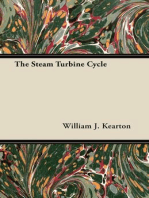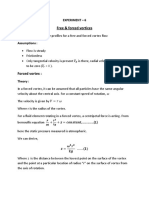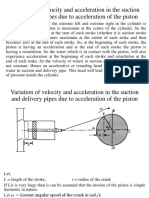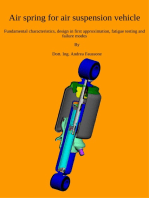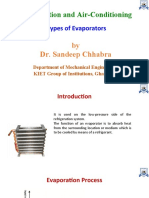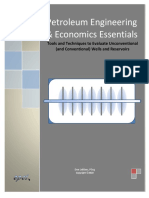0 ratings0% found this document useful (0 votes)
145 viewsMaximum Speed of A Reciprocating Pump
Maximum Speed of A Reciprocating Pump
Uploaded by
SAATVIK JAINThe maximum speed of a reciprocating pump is calculated separately for the suction and delivery strokes.
During the suction stroke, the pressure must not fall below the vapor pressure, otherwise cavitation will occur. The maximum speed is calculated using equations that relate the suction head, atmospheric pressure, and acceleration pressure at the start of the stroke.
During the delivery stroke, the pressure also must not fall below vapor pressure, and separation could occur at the end of the stroke. The maximum speed is similarly calculated using equations relating the delivery head, atmospheric pressure, and acceleration pressure at the end of the stroke.
The true maximum speed is the lower of the speeds calculated for the suction and delivery strokes, as
Copyright:
© All Rights Reserved
Available Formats
Download as PDF, TXT or read online from Scribd
Maximum Speed of A Reciprocating Pump
Maximum Speed of A Reciprocating Pump
Uploaded by
SAATVIK JAIN0 ratings0% found this document useful (0 votes)
145 views4 pagesThe maximum speed of a reciprocating pump is calculated separately for the suction and delivery strokes.
During the suction stroke, the pressure must not fall below the vapor pressure, otherwise cavitation will occur. The maximum speed is calculated using equations that relate the suction head, atmospheric pressure, and acceleration pressure at the start of the stroke.
During the delivery stroke, the pressure also must not fall below vapor pressure, and separation could occur at the end of the stroke. The maximum speed is similarly calculated using equations relating the delivery head, atmospheric pressure, and acceleration pressure at the end of the stroke.
The true maximum speed is the lower of the speeds calculated for the suction and delivery strokes, as
Original Title
Maximum Speed of a Reciprocating Pump
Copyright
© © All Rights Reserved
Available Formats
PDF, TXT or read online from Scribd
Share this document
Did you find this document useful?
Is this content inappropriate?
The maximum speed of a reciprocating pump is calculated separately for the suction and delivery strokes.
During the suction stroke, the pressure must not fall below the vapor pressure, otherwise cavitation will occur. The maximum speed is calculated using equations that relate the suction head, atmospheric pressure, and acceleration pressure at the start of the stroke.
During the delivery stroke, the pressure also must not fall below vapor pressure, and separation could occur at the end of the stroke. The maximum speed is similarly calculated using equations relating the delivery head, atmospheric pressure, and acceleration pressure at the end of the stroke.
The true maximum speed is the lower of the speeds calculated for the suction and delivery strokes, as
Copyright:
© All Rights Reserved
Available Formats
Download as PDF, TXT or read online from Scribd
Download as pdf or txt
0 ratings0% found this document useful (0 votes)
145 views4 pagesMaximum Speed of A Reciprocating Pump
Maximum Speed of A Reciprocating Pump
Uploaded by
SAATVIK JAINThe maximum speed of a reciprocating pump is calculated separately for the suction and delivery strokes.
During the suction stroke, the pressure must not fall below the vapor pressure, otherwise cavitation will occur. The maximum speed is calculated using equations that relate the suction head, atmospheric pressure, and acceleration pressure at the start of the stroke.
During the delivery stroke, the pressure also must not fall below vapor pressure, and separation could occur at the end of the stroke. The maximum speed is similarly calculated using equations relating the delivery head, atmospheric pressure, and acceleration pressure at the end of the stroke.
The true maximum speed is the lower of the speeds calculated for the suction and delivery strokes, as
Copyright:
© All Rights Reserved
Available Formats
Download as PDF, TXT or read online from Scribd
Download as pdf or txt
You are on page 1of 4
Maximum speed of a reciprocating pump
The pressure in the cylinder during suction stroke or delivery stroke,
must not be allowed to fall below the vapour pressure of liquid,
flowing through suction or delivery pipe. If the pressure in the cylinder
is below the vapour pressure, the dissolved gasses will be liberated
from that liquid and cavitation will take place. And the continuity of
flow of liquid will not exist which means the separation of liquid will
take place. The pressure at which separation takes place, is called
separation pressure and corresponding pressure head is called
separation pressure head. Separation pressure head is denoted by
ℎ𝑠𝑒𝑝 . The limiting value of ℎ𝑠𝑒𝑝 for water is 7.8 m below atmospheric
pressure head or 10.3 – 7.8 = 2.5 m abs. The separation may take place
during suction stroke or delivery stroke. The maximum speed of the
reciprocating pump during suction and delivery stokes is calculated as :
(a) Maximum speed during suction stroke
Let’s consider the suction stroke. During suction stroke, the value of absolute pressure head is
minimum at the beginning of the stroke. So, the separation may take place at the beginning of
the stroke only. So, in the limiting case, the abs. pressure head in the cylinder at the beginning of
the stroke will be equal to separation pressure head (ℎ𝑠𝑒𝑝 ).
So, ℎ𝑠𝑒𝑝 = 𝐻𝑎𝑡𝑚 - (ℎ𝑠 + ℎ𝑎𝑠 ) (abs.)
ℎ𝑎𝑠 = 𝐻𝑎𝑡𝑚 - ℎ𝑠 - ℎ𝑠𝑒𝑝 ……………………..(i)
Where 𝐻𝑎𝑡𝑚 = atmospheric pressure head, ℎ𝑠 = suction head, ℎ𝑎𝑠 = pressure head due to
acceleration at the beginning of suction stroke
We know,
𝑙 𝐴
ℎ𝑎𝑠 = 𝑠 X 𝜔2 r …………………………………….(ii)
𝑔 𝑎𝑠
Where symbols have usual meanings.
Equating the value of ℎ𝑎𝑠 from Equation (i) and equation (ii)
𝑙 𝐴
𝐻𝑎𝑡𝑚 - ℎ𝑠 - ℎ𝑠𝑒𝑝 = 𝑠 X 𝜔2 r………………....(iii)
𝑔 𝑎𝑠
From this equation (iii), the value of 𝜔 can be calculated. From this value of 𝜔, the speed N can
be calculated, which will be the maximum speed of the reciprocating pump during suction stroke
without separation.
(b)Maximum speed during delivery stroke
Let’s consider the delivery stroke. During delivery stroke, the value of absolute pressure head is
minimum at the end of the stroke. So the separation may take place at the end of the stroke only.
So, in the limiting case, the abs. pressure head in the cylinder at the end of the stroke will be
equal to separation pressure head (ℎ𝑠𝑒𝑝 ).
So, ℎ𝑠𝑒𝑝 = (𝐻𝑎𝑡𝑚 + ℎ𝑑 ) - ℎ𝑎𝑑 (abs.)
ℎ𝑎𝑑 = (𝐻𝑎𝑡𝑚 + ℎ𝑑 ) - ℎ𝑠𝑒𝑝 ……………………..(iv)
Where 𝐻𝑎𝑡𝑚 = atmospheric pressure head, ℎ𝑑 = delivery head, ℎ𝑎𝑑 = pressure head due to
acceleration at the end of the delivery stroke
We know,
𝑙 𝐴
ℎ𝑎𝑑 = 𝑑 X 𝜔2 r ……………………………………….(v)
𝑔 𝑎𝑑
Where symbols have usual meanings.
Equating the value of ℎ𝑎𝑑 from Equation (iv) and equation (v)
𝑙 𝐴
(𝐻𝑎𝑡𝑚 + ℎ𝑑 ) - ℎ𝑠𝑒𝑝 = 𝑑 X 𝜔2 r ………………….(vi)
𝑔 𝑎𝑑
From this equation (vi), the value of 𝜔 can be calculated. From this value of 𝜔, the speed N can be
calculated, which will be the maximum speed of the reciprocating pump during delivery stroke
without separation.
The minimum of the two speeds given by the above two cases (a) and (b),
is the maximum speed of the reciprocating pump without separation
during suction and delivery strokes.
You might also like
- SchlierenDocument14 pagesSchlierenPhani Kiran VadlamaniNo ratings yet
- UOT Fanno FlowDocument36 pagesUOT Fanno FlowVishnu SreekumarNo ratings yet
- Goulds-Pumps Fundamentals PDFDocument140 pagesGoulds-Pumps Fundamentals PDFAgustinus Made Theo Dwijaya100% (5)
- Urry-Mobilities - CH 4-7Document49 pagesUrry-Mobilities - CH 4-7Jamie Lee MarksNo ratings yet
- 0987-178 HRM Course Outline Winter 2022 SessionDocument7 pages0987-178 HRM Course Outline Winter 2022 SessionAnisha ChandraNo ratings yet
- Kepler Astrology Software (Cracked)Document2 pagesKepler Astrology Software (Cracked)Megatore75% (4)
- Reciprocating PumpDocument7 pagesReciprocating PumpAnkush JainNo ratings yet
- Calculation Head Centrifugal Pump in MetricDocument8 pagesCalculation Head Centrifugal Pump in MetricAshok PatelNo ratings yet
- Pump Equations and Formulas CalculatorDocument11 pagesPump Equations and Formulas CalculatorOmar Elhady100% (3)
- Is 5120Document52 pagesIs 5120Otavio123No ratings yet
- De Laval NozzleDocument6 pagesDe Laval Nozzlethiago sousaNo ratings yet
- Main and Non-Condensable Gases Ejectors Report: Figure 3: Principle Structure of EjectorDocument11 pagesMain and Non-Condensable Gases Ejectors Report: Figure 3: Principle Structure of EjectorUnc StappyNo ratings yet
- Calculating The System HeadDocument9 pagesCalculating The System HeadSam Wing HongNo ratings yet
- Pump Head CalculationDocument10 pagesPump Head CalculationHussien Al-gaafary100% (4)
- Mehran University of Engineering and Technology SZAB Campus Khairpur Mir'sDocument64 pagesMehran University of Engineering and Technology SZAB Campus Khairpur Mir'sMarcusHuynh88No ratings yet
- Prelim Report Lab KhimDocument18 pagesPrelim Report Lab KhimMihts ZyelNo ratings yet
- Calculating The System Head PDFDocument9 pagesCalculating The System Head PDFIrfanshah2013No ratings yet
- Pump ExpDocument14 pagesPump ExpBIPIN SHARMANo ratings yet
- effectof acceleration and friction on indicator diagramDocument4 pageseffectof acceleration and friction on indicator diagramMESA AMBADNo ratings yet
- System Head in Metric UnitsDocument7 pagesSystem Head in Metric UnitsrammysiNo ratings yet
- Convergent-Divergent Nozzle: Technical BackgroundDocument4 pagesConvergent-Divergent Nozzle: Technical BackgroundRaghunandan A Rao100% (1)
- Te-2 Unit - 2Document58 pagesTe-2 Unit - 2Krishna VamsiNo ratings yet
- Intakeand Exhaust and Inlet Process21Document25 pagesIntakeand Exhaust and Inlet Process21مصطفى عبدالله عبدالرحمن اغاNo ratings yet
- Abhishek Thakur Xi-F 15 Physics Project File: Mechanical Properties of FluidsDocument14 pagesAbhishek Thakur Xi-F 15 Physics Project File: Mechanical Properties of FluidsAbhishek ThakurNo ratings yet
- Negative Slip, Flow Separation Conditions, Air VesselsDocument7 pagesNegative Slip, Flow Separation Conditions, Air Vesselsminesh.manu6531No ratings yet
- Thermodynamics Nozzle 1Document19 pagesThermodynamics Nozzle 1waseemjuttNo ratings yet
- Thermal Engineering-NozzleDocument12 pagesThermal Engineering-NozzleJayNo ratings yet
- WER 360S - Pumps - Part 2 RevDocument41 pagesWER 360S - Pumps - Part 2 Revabonga petseNo ratings yet
- Lec 12Document17 pagesLec 12YOO SHINNo ratings yet
- Flow Through Converging-Diverging Passages: Convergent NozzlesDocument10 pagesFlow Through Converging-Diverging Passages: Convergent NozzlesRobin BinoyNo ratings yet
- Mock Test 4 - 16650681 - 2023 - 04 - 12 - 14 - 33Document66 pagesMock Test 4 - 16650681 - 2023 - 04 - 12 - 14 - 33vijeesh v jNo ratings yet
- Converging Diverging NozzleDocument9 pagesConverging Diverging NozzleSiva RamanNo ratings yet
- Compressible Flow Through Convergent and Laval NozzlesDocument10 pagesCompressible Flow Through Convergent and Laval NozzlesIshwar SinghNo ratings yet
- Cavitation NotesDocument12 pagesCavitation NotesrajeevNo ratings yet
- Reciprocating PumpDocument5 pagesReciprocating Pumpahsanul haqueNo ratings yet
- Lec 23Document8 pagesLec 23YOO SHINNo ratings yet
- FM-II Week 12Document11 pagesFM-II Week 12Hassan RazaNo ratings yet
- Libro de BombasDocument260 pagesLibro de BombasBoris SalazarNo ratings yet
- Pressure Distribution Over CylinderDocument4 pagesPressure Distribution Over CylinderAshok YadavNo ratings yet
- MTH642 (Assignment 1 SOLUTION SPRING 2023Document5 pagesMTH642 (Assignment 1 SOLUTION SPRING 2023Muhammad AqeelNo ratings yet
- Experiment (7) Free and Forced VortexDocument3 pagesExperiment (7) Free and Forced Vortexmanoj100% (1)
- 02 - 1a Total Dynamic HeadDocument55 pages02 - 1a Total Dynamic HeadAndre Damara100% (1)
- TurbomachineryDocument8 pagesTurbomachineryKelvin NyongesaNo ratings yet
- Chapter 3 TurbomachineDocument60 pagesChapter 3 TurbomachineMohd Soufian100% (1)
- Drag Force ExperimentDocument12 pagesDrag Force ExperimentRyshal ZeffreyNo ratings yet
- Reciprocating PumpsDocument16 pagesReciprocating PumpsMahmoud AfifyNo ratings yet
- University of Lahore, Islamabad Campus: Nozzle Thermpdynamics-Ii Engr. Babar AshfaqDocument65 pagesUniversity of Lahore, Islamabad Campus: Nozzle Thermpdynamics-Ii Engr. Babar AshfaqGhaffar KhanNo ratings yet
- Impulse TurbineDocument8 pagesImpulse TurbineMuhammad Waleed TariqNo ratings yet
- Variation of Velocity and Acceleration in Suction and Delivery Pipes Due To Acceleration of PistonDocument9 pagesVariation of Velocity and Acceleration in Suction and Delivery Pipes Due To Acceleration of PistonSAATVIK JAINNo ratings yet
- Turbo Machine: Ioe, T CDocument35 pagesTurbo Machine: Ioe, T CCalcgen EngineeringNo ratings yet
- Tutorial 3 Fluid Kinematics (Chapter 3)Document5 pagesTutorial 3 Fluid Kinematics (Chapter 3)Naser KhalidNo ratings yet
- How Does Pump Suction Limit The FlowDocument6 pagesHow Does Pump Suction Limit The FlowNilesh GohelNo ratings yet
- The Petrol Engine: A Text-book dealing with the Principles of Design and Construction, with a Special Chapter on the Two-stroke EngineFrom EverandThe Petrol Engine: A Text-book dealing with the Principles of Design and Construction, with a Special Chapter on the Two-stroke EngineNo ratings yet
- The Mechanics of Water-Wheels - A Guide to the Physics at Work in Water-Wheels with a Horizontal AxisFrom EverandThe Mechanics of Water-Wheels - A Guide to the Physics at Work in Water-Wheels with a Horizontal AxisNo ratings yet
- How to Select the Right Centrifugal Pump: A Brief Survey of Centrifugal Pump Selection Best PracticesFrom EverandHow to Select the Right Centrifugal Pump: A Brief Survey of Centrifugal Pump Selection Best PracticesRating: 5 out of 5 stars5/5 (1)
- RAC - Unit 5 - Types of EvaporatorsDocument12 pagesRAC - Unit 5 - Types of EvaporatorsSAATVIK JAINNo ratings yet
- Lecture 2Document4 pagesLecture 2SAATVIK JAINNo ratings yet
- RAC - Unit-5 - Liquefaction of AirDocument3 pagesRAC - Unit-5 - Liquefaction of AirSAATVIK JAINNo ratings yet
- RAC-Unit-5 - Food PreservationDocument13 pagesRAC-Unit-5 - Food PreservationSAATVIK JAINNo ratings yet
- RAC - Unit 5 - Vortex Tube Refrigeration SystemDocument7 pagesRAC - Unit 5 - Vortex Tube Refrigeration SystemSAATVIK JAINNo ratings yet
- RAC - Unit 5 - Working of Window ACDocument11 pagesRAC - Unit 5 - Working of Window ACSAATVIK JAINNo ratings yet
- RAC Unit-5 DuctDocument27 pagesRAC Unit-5 DuctSAATVIK JAINNo ratings yet
- Refrigeration and Air-Conditioning: Unit - 4Document89 pagesRefrigeration and Air-Conditioning: Unit - 4SAATVIK JAINNo ratings yet
- Refrigeration and Air-Conditioning: Unit-3Document39 pagesRefrigeration and Air-Conditioning: Unit-3SAATVIK JAINNo ratings yet
- Refrigeration and Air-Conditioning: Unit - 3Document30 pagesRefrigeration and Air-Conditioning: Unit - 3SAATVIK JAINNo ratings yet
- Variation of Velocity and Acceleration in Suction and Delivery Pipes Due To Acceleration of PistonDocument9 pagesVariation of Velocity and Acceleration in Suction and Delivery Pipes Due To Acceleration of PistonSAATVIK JAINNo ratings yet
- Discharge, Work Done For Single-Acting Reciprocating PumpDocument5 pagesDischarge, Work Done For Single-Acting Reciprocating PumpSAATVIK JAINNo ratings yet
- Effect of Friction in Suction and Delivery Pipes On Indicator DiagramDocument9 pagesEffect of Friction in Suction and Delivery Pipes On Indicator DiagramSAATVIK JAINNo ratings yet
- Detailed Lesson PlanDocument15 pagesDetailed Lesson PlanFrances Marie Z. CieloNo ratings yet
- Cottagecore Aesthetic Style Thesis by SlidesgoDocument45 pagesCottagecore Aesthetic Style Thesis by SlidesgoKIARA ARIASNo ratings yet
- E53-07 (Reapproved 2013) PDFDocument4 pagesE53-07 (Reapproved 2013) PDFearth metallurgical services pvt.ltd.No ratings yet
- FPGA Implementation of Nerve Cell Using Izhikevich Neuronal Model As Spike Generator SGDocument10 pagesFPGA Implementation of Nerve Cell Using Izhikevich Neuronal Model As Spike Generator SGahsan321No ratings yet
- Construction of Main Dam and Appurtenant Works of Madri (Earthen) Dam, Open Cut, Intake Structure and Link Tunnel From Madri Dam To Main TunnelDocument32 pagesConstruction of Main Dam and Appurtenant Works of Madri (Earthen) Dam, Open Cut, Intake Structure and Link Tunnel From Madri Dam To Main Tunnelavinash chechaniNo ratings yet
- Class Program Pinakabago SY 2023 2024Document8 pagesClass Program Pinakabago SY 2023 2024Al EstabNo ratings yet
- Attachment Selector: Machine ConfigurationDocument4 pagesAttachment Selector: Machine ConfigurationBilal VURALNo ratings yet
- TB - 04 - Superwised LearningDocument24 pagesTB - 04 - Superwised LearningMOHANNo ratings yet
- Сущ. В1-В2Document24 pagesСущ. В1-В2Vladimir ShlykNo ratings yet
- 10 Instruction Sheet DOP B07S410Document2 pages10 Instruction Sheet DOP B07S410Nisar AhmedNo ratings yet
- Radioactivity 2 QP-1Document11 pagesRadioactivity 2 QP-1yobel85No ratings yet
- Practice Test C - Reading: LineDocument12 pagesPractice Test C - Reading: LineijumNo ratings yet
- Digital Twin in GeneralDocument18 pagesDigital Twin in GeneralFabricio Rosado UrquhartNo ratings yet
- Guide For The Preparation of Chapter 2 Powerpoint PresentationDocument2 pagesGuide For The Preparation of Chapter 2 Powerpoint PresentationKENT BENEDICT PERALESNo ratings yet
- Planet-Carrier-Design CalculationDocument1 pagePlanet-Carrier-Design CalculationvijaykhandgeNo ratings yet
- PE EssentialsDocument608 pagesPE EssentialsMukisa HermanNo ratings yet
- TranscriptDocument1 pageTranscriptaubreylnixNo ratings yet
- Case Study 14 - Datu & TurgoDocument16 pagesCase Study 14 - Datu & Turgokenth datuNo ratings yet
- Clause and Sentence: Correlation and Correspondence: Mohammad Mozammel HaqueDocument7 pagesClause and Sentence: Correlation and Correspondence: Mohammad Mozammel HaqueOrevaogheneNo ratings yet
- Series: Highly Sensitive Manual Tuning Made EasyDocument16 pagesSeries: Highly Sensitive Manual Tuning Made EasyviniciusNo ratings yet
- 7 Tricky Work Situations, and How To Respond To ThemDocument10 pages7 Tricky Work Situations, and How To Respond To Thempriti.shahNo ratings yet
- Essay of IndiaDocument8 pagesEssay of Indiaafhbdbsyx100% (2)
- 3.6 - Add and Subtract PolynomialsDocument4 pages3.6 - Add and Subtract Polynomialsututoringunion1No ratings yet
- Workforce Past Questions and Answers 2024Document11 pagesWorkforce Past Questions and Answers 2024myjobtestsngNo ratings yet
- 11Nc Dec10Document11 pages11Nc Dec10Nhật NguyễnNo ratings yet
- Le Cpar GamabaDocument4 pagesLe Cpar Gamabakreeztyn montserratNo ratings yet
- Types of Student-The LeaderDocument2 pagesTypes of Student-The LeaderBernard Ah Thau TanNo ratings yet




